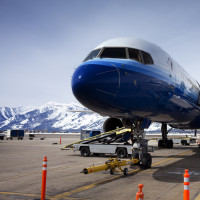Fatal Plane Crashes at Santa Monica and Jackson Hole Airports Leave Six Dead

Update on Santa Monica Plane Crash
The National Transportation Board (NTSB) has released its preliminary report on the
September 29th crash at the Santa Monica Airport that killed all four people on board (See Four Die in Santa Monica Private Plane Crash, posted October 3, 2013). While the cause of the crash has not yet been determined, a couple of factors have been eliminated. According to the NTSB report, there was no evidence of debris on the runway, and all three of the Cessna’s landing gear tires were inflated and showed no patterns of unusual wear. Something else, therefore, is responsible for causing the plane to veer off the runway shortly after touching down, where it crashed into a hangar and burst into flames.
*****************
Fatal Crash at Jackson Hole Airport Leaves Two Dead
On September 11th, a single-engine plane departing Jackson Hole Airport (JAC) in Wyoming and bound for Fort Collins-Loveland Municipal Airport in Colorado lost power while maneuvering in the traffic pattern shortly after takeoff. The plane crashed about 3,100 feet from the runway, killing the pilot and the sole passenger aboard. According to the preliminary report in the National Transportation Safety Board database, the pilot had been notified by the air traffic controller before takeoff that wind conditions were from 040 degrees at 15 knots, although immediately after the accident, the controller had transmitted information to another aircraft that the wind was from 050 degrees at 16 knots gusting to 26 knots. Possibly the wind played a factor in the accident, although it is too early in the investigation to know for sure.
Difficult Terrain, Weather Patterns at Jackson Hole
Jackson Hole, Wyoming is located in a valley in the midst of the Grand Teton mountain range (interestingly, it is the only airport in the country located inside a national park). JAC is described as a “challenging airport” and a “unique airport” by the airport’s own website. The airport is also designated as “Special” by the FAA. For airports designated as special due to the surrounding terrain or complex approach or departure procedures, pilots are expected to hold certain qualifications before using the airport as a pilot in command.
Several Planes Landing at JAC Drive Off the Runway Every Year
Usually it is the approach and touchdown that is the most challenging maneuver at JAC, with a constant risk of runway excursion or overrun from the airport’s sole, relatively short runway (only 6,300 feet long). In fact, JAC has the highest excursion/overrun rate of any airport in the U.S. The FAA issued a Safety Alert For Operators (SAFO 11011) in 2011 to alert operators of the danger of runway excursions at JAC. The FAA’s Northwest Mountain Office of Runway Safety has also prepared a brief article on Preventing Runway Excursions at the Jackson Hole Airport. In addition to the short runway, the airport’s elevation and weather patterns, and the fact that landing is both downwind and downhill, presents many challenges to aircraft operators. The airport, which handles about 25,000 operations a year, has upgraded several safety features in recent years, including the addition of 950 feet of paved runway safety area in 2011 to help mitigate personal injury and aircraft damage in the event of an overrun.


 Close Menu
Close Menu